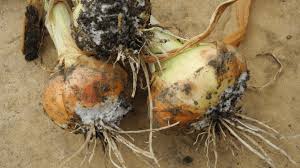Onion white rot is the most devastating disease for allium crops worldwide, threatening the growth of onions, garlic, leeks, shallots, and ornamental alliums. It’s so severe that in some regions, it has decimated the entire allium industry. While there’s no cure at present, there are steps you can take to prevent it from spreading and limit its damage if it affects your garden.
Symptoms of Onion White Rot
White rot affects all allium species, with garlic being the most susceptible, followed by onions. Shallots and leeks are less commonly affected, though they can still fall victim to the disease. The most alarming feature of onion white rot is that it’s often symptomless until it’s too late.
The first noticeable sign is typically yellowing leaves, often right before harvest when the leaves would naturally begin to die back. This can easily be confused with normal plant behavior, making the disease difficult to detect early on.

When digging up infected plants, they often come out of the soil with ease. If the disease is advanced, you may see a fluffy white mold covering the basal plate (the area where roots sprout). Black, poppy-seed-like structures, called sclerotia, will be scattered across the mold. In severe cases, the entire bulb may be blackened and rotted.
The sclerotia are responsible for spreading the disease. These tiny growths remain in the soil until they come into contact with the roots of another allium plant. Once triggered by plant chemicals, they germinate and begin to infect the new crop.
How to Control Onion White Rot
Currently, there is no allium variety resistant to white rot, so prevention is key. When purchasing plants, ensure they come from certified disease-free stock, and carefully inspect the basal plate for any signs of mold. If possible, consider starting your crops from seed.
If you discover white rot in your garden, immediately remove and dispose of any infected plants. Do not compost them, as this will spread the disease. If only a small portion of the crop is affected, you may still be able to use the produce, but it should be consumed fresh or frozen, as it will not store well.

To prevent the spread of the disease, thoroughly wash soil off boots, tools, and hands after handling infected plants. Crop rotation can help reduce the disease’s spread, but sclerotia can survive in the soil for up to 20 years, making this method only partially effective. In some cases, growing alliums in containers with fresh potting soil may be a more practical solution.
Experimental Methods: Garlic Extract
One promising but experimental method for combating white rot is the use of garlic extract. The idea is that the allicin, the chemical responsible for garlic’s distinct smell, tricks sclerotia into germinating. Without a host plant to infect, the sclerotia will starve and die.
To make garlic extract, crush a clean bulb of garlic (discard the papery skin and basal plate) and mix it with 10 liters (2 gallons) of water. Apply this solution to areas of your garden where you aren’t currently growing alliums. For best results, apply the mixture when soil temperatures range between 15°C and 18°C (59°F – 64°F), as this is the optimal temperature for sclerotia germination.
Alternatively, garlic powder can be used in place of fresh garlic. This method is still experimental, but it shows some promise in reducing disease pressure.
Conclusion
Onion white rot is a severe threat to allium crops, but with careful management and prevention, you can minimize its impact. Starting from disease-free plants, inspecting for early signs of infection, practicing crop rotation, and trying garlic extract treatment are all valuable strategies. If you’ve tried other methods or have had success with any of these, share your experiences with fellow gardeners—every bit of knowledge helps in the fight against this persistent disease.
